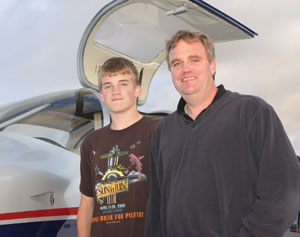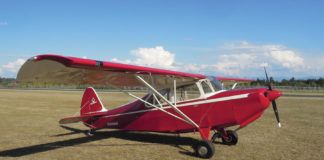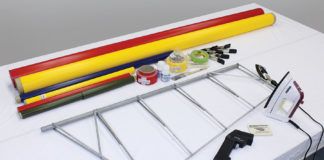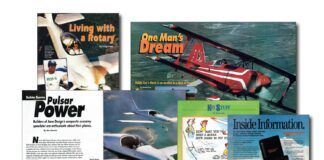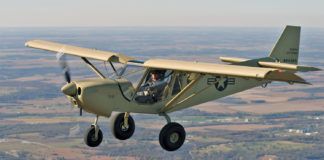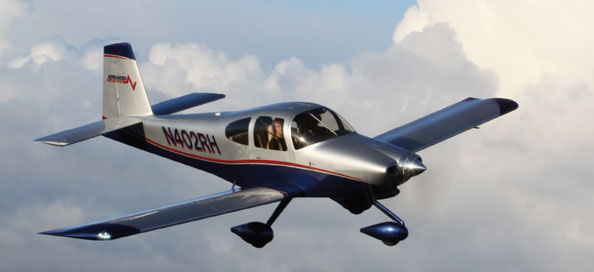
Measuring success takes more than a glimpse at the numbers. Here’s an example. By the first quarter of 2010, a mere 15 more RV-10s were flying than RV-3s, according to Van’s Aircraft figures. At 282 units completed and put to task, the RV-10 fleet heads only the RV-3 and the RV-12; the RV-6/6A fleet is some eight and a half times larger.
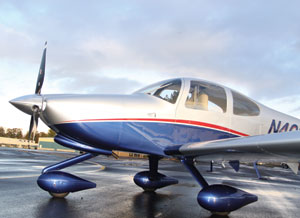
Smooth lines disguise the big, honkin’ motor under the cowling. Buyers were offered the option of the six-cylinder, 210-hp Continental IO-360. They yawned.
And yet, don’t you feel like you see RV-10s everywhere? Seven years into its lifespan—the RV-10 was first offered in 2003—Van’s largest kit continues to percolate along. Maybe it’s perception. The RV-10 lays down a long shadow, literally and figuratively. In a market that had only a few genuine four-place aircraft at the time, the RV-10 reset expectations.
In the Beginning
Looking back, it’s hard to imagine the RV-10 as a gamble for Van’s Aircraft. But Van’s chief engineer, Ken Krueger, says otherwise. “We were deciding what to do next, and looked closely at the four-place market. We had never gone there, and wanted to be sure it was viable.” When Van’s considered moving ahead with a new project in the late 1990s and through 2000, several options were on the table, including the concept of a four-place RV. It would prove to be good timing.
During the late 1980s and early 1990s, several new four-place designs arrived, but few of them survived. For every Lancair IV and Velocity, there were several Wheeler Expresses and Prescott Pushers. As Van’s began its domination of the two-place market, there were still questions about the volume and durability of a four-place offering that wasn’t “fast glass.”
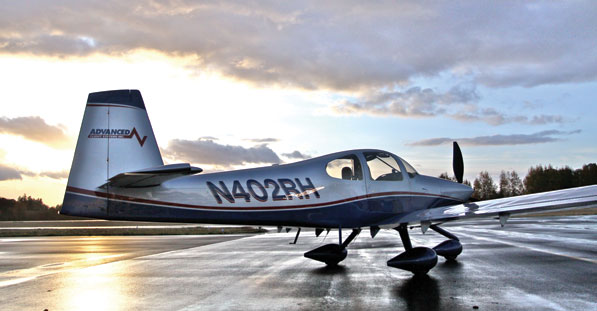
“By that time,” says Krueger, “we felt that the four-place homebuilt market had matured enough for it to make sense. Van [CEO Dick VanGrunsven] wanted to have a model that had the same performance of our two-place airplanes and nice flying qualities.” Even so, the flying qualities would be suited to the mission. “We wanted the RV-10 to have the ‘family’ feel to it but be appropriate.”
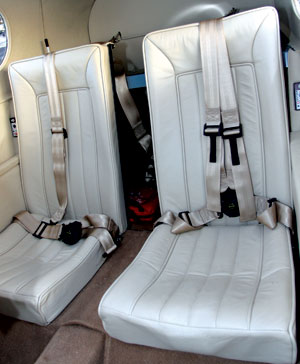
Split back seats can be removed to increase cargo capacity.
While it makes sense to have the RV-10 provide some familiar cues to the two-seaters, there was actually sound engineering at work. “Our desire for good performance—all-around performance—led to things like selecting a certain size of wing or power-to-weight ratios,” Krueger says. So early in the process, Van’s engineering elected to follow a formula that worked in the two-seaters: Design the structure to keep the airframe as light as possible, provide wing of sufficient size to permit a low stall speed and use only enough power to get the job done in a satisfying way. While Krueger never explicitly said as much, it’s not hard to see that designing a fire-breathing, speed-at-all-costs airplane was never considered.
“We looked at the whole,” says Krueger. “Knowing this would be a four-seat, family airplane caused us to look at things like cabin size, the way the doors are designed, things like that. You can’t have a canopy on a four-place airplane. Sure, it’s been done,” he says, letting the subject drop. Tiger and Navion owners will disagree, but it can be fairly said that a four-place, canopied airplane is a compromise at best. You never quite achieve that full “fighter” feeling, and yet you’ll usually get wet egressing in a rain shower.

Front seats by Fliteline Interiors are firm and comfortable. Notice that the cabin is wide enough to accommodate a small center console.
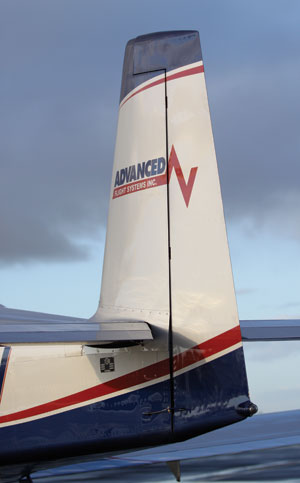
It’s the same shape and layout of all RV rudders, just bigger.
“The doors are designed with convenience in mind,” Krueger says. “They’re top hinged for a reason, so that they provide a little protection from rain while the passengers board, and they’re positioned to give a good compromise of front- and rear-seat access. In fact, it’s actually slightly easier to get into the back than the front.”
The RV-10, as its builders know, represents a break for the company in the use of semi-structural composites. “We had to have that cabin top do a lot of things,” Krueger says. “It is the rollover structure for the cabin, it locates the windows and doors, and it has compound curvature so you get a good looking airplane.” Asked if Van’s had considered a truly all-metal RV-10, Krueger admits that drawings were made using a shaped-metal cabin top, but it didn’t look as good as the composite version and actually was more complex. “When we looked at the number of pieces needed for the doors, and window frames and channels, things like that, the composite top looked better and better,” says Krueger.
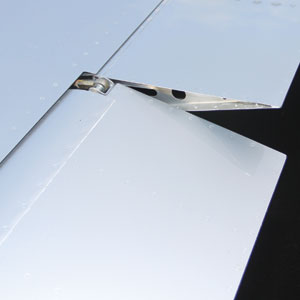
Tight-fitting control surfaces help aerodynamic efficiency. Great care in surface size, hinge placement and control geometry guarantee excellent handling qualities.
Engine Options
When the desired cabin size and performance targets were considered, it became clear to Van’s that the 10 would need between 210 and 260 horsepower—a range that’s actually a bit hard to span. On the low end, you have the six-cylinder Continental IO-360 and the Lycoming IO-390, a four cylinder. When the RV-10 was developed, the only four in the power range was the IO-360 angle-valve engine, but it didn’t quite get there. Van’s wasn’t about to foist a poor-performing airplane onto builders, so it was resolved that the primary engine would be the 260-hp, six-cylinder Lycoming. What’s more, while Van’s data includes extrapolated performance from a 235-hp version of the 540 Lycoming, it hasn’t been the engine of choice by any means. Easy to see why: The 260-hp version costs about the same (new), weighs the same and fits into the same footprint. The only reason to opt for the 235-hp model is if you find a used one cheap.
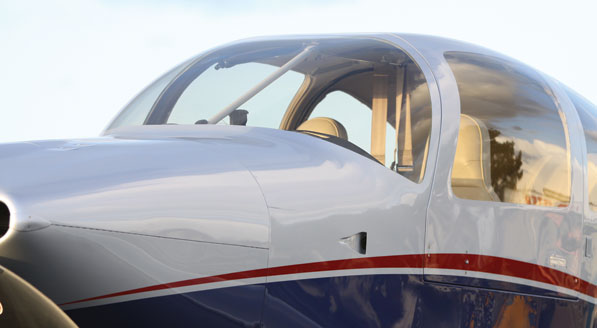
A sloped cowling and high upper corners of the windshield help create excellent visibility for the pilot. Note the steel-tube cabin reinforcement; the RV-10 was tested to stringent rollover standards.
An interesting aside. “We did consider making room for the angle-valve four-cylinder,” says Krueger. “And if we made a new cowling, it would work.” The engine mount would have to be longer in order to keep the prop arc about where it is with the IO-540, but the cowling would actually have to be broader. The IO-360/390 engines have larger heads and need a wider cowling than the parallel-valve six. “But then we could see builders taking that cowling, mating it with the IO-540 engine mount, and installing a 300-hp engine,” says Krueger. That weight (about 35 pounds more), power (30 to 40 more) and speed were just not something the RV-10 was designed for, and Van’s has been adamant that 260 hp is more than enough.
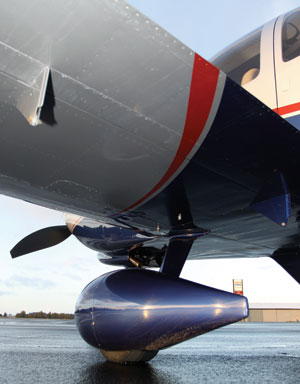
Large wheels and generous flap area make the RV-10 at home on unimproved strips. In fact, Hickman flies his off a grass strip in front of his house.
Airframe in Focus
The more the engineering team worked on the RV-10, the more “traditional Van’s” solutions clearly made sense, and part of this circles back to the desire of creating a true RV in handling, balance and performance. Use of a constant-chord wing was almost a given, but not quite—until the calculations for the necessary wing area and an acceptable span loading concluded that the current 31.8-foot wingspan would be a good compromise. Although the RV-10 has 13% more span loading than an RV-8, it would be difficult for the company to build a longer wing. “We already have a minor splice in the 10 wing,” Krueger says, “and we do have to think about actually producing the kits economically.”
In all of the important systems, the RV-10 is very much an RV. Pushrods link the twin sticks to the ailerons and elevator. Trim is by a tab and electric motor. Flaps are electric, the rudder cable operated. Tricycle landing gear—there is no taildragger option now, probably never will be—is the normal RV steel-tube struts with a free-castering nosewheel. Aside from the swoopy top, the RV-10 could easily be mistaken for an RV-7A with a glandular problem.
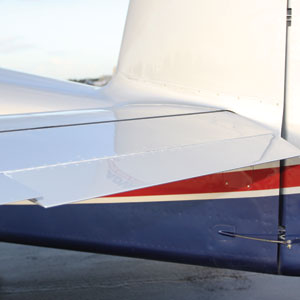
Electric pitch trim comes via a simple flap on the left elevator.
Family Traits in the Air
My most recent experience with the RV-10 came thanks to Advanced Flight Systems’ Rob Hickman, who built the example seen here as both a family wagon and an evaluation platform for his EFIS equipment. (See “Family Hauler, Testbed,” Page 13.) Naturally, the panel is AFS-centric with twin AF-4500s on the left and an AF-3500 on the right—bolstered by a PS Engineering PMA-9000EX audio panel, Garmin GNS 430W GPS/com, Garmin SL30 nav/com, Garmin GTX 330 Mode S transponder, and Garmin GPSMAP 495 in an AirGizmos mount as a backup GPS. The autopilot is a specially reprogrammed unit that’s functionally similar to the TruTrak DigiFlight II VSGV.
Hey, You Down There!
Step up on the tall wing, hang onto the overhead rollover structure and ease yourself down and forward to the pilot seat. Slide it forward a notch and get comfortable. RV aficionados might first notice that the front-row companion has mounted without the two of you brushing elbows. Look over your shoulder to see a back seat area as large as a Cessna 182’s. From the outside you might have spied the graceful arc formed by the overhead as it descends to the empennage; that bump is for rear-seat headroom and it’s effective.
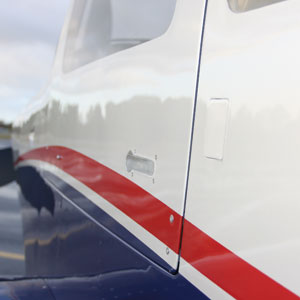
The overhead doors have not been trouble free. A recent factory service bulletin instructs owners to install a supplementary latch to keep the doors from leaving the airplane in the event that they come unlatched during flight.
Hickman’s airplane is injected. A standard Lycoming IO-540-D lies behind the 76-inch three-blade Hartzell composite prop, and it starts with the usual flurry of fingers. His is a well-balanced engine that ticks along smoothly and quietly as you taxi toward the runway. A free-turning nosewheel responds quickly to jabs of brake, but the rudder isn’t effective at a walking pace. Pilots accustomed to the low-slung two-seaters will be amazed by the commanding view afforded by the RV-10. Because the cowling is relatively narrow at the front, on-ground visibility is excellent.
On the runway, gradual application of power permitted the nose to track the centerline with a generous application of rudder and just a touch on the brake. By the time your hand is done moving the throttle, the rotation speed of 50 knots indicated (KIAS) has come and gone. The first big surprise: Expecting a bit of two-seat RV to remain in the Big 10, I began gradually applying backpressure to the stick. Wrong. Stick forces are considerably greater than in, say, an RV-9A, and I had to rapidly increase the pitch input to rotate this 10. By that time, the airplane was more than eager to leave the ground. Hickman gave me a sidelong glance from the right seat. Oh, well.
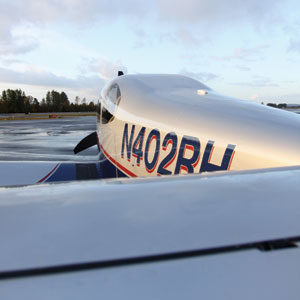
The gentle break from the nearly flat empennage to the cabin top ensures back-seaters have plenty of headroom.
Initial climb was strong, beginning at about 1600 fpm and tapering to 1200 fpm as I allowed the nose to drop to the horizon—as such, the airspeed crept up to 100 and then to 110 KIAS. Fuel flow was fairly prodigious in the climb, starting at more than 20 gph and tapering as we went up. We didn’t climb very high, as one of the requirements of the flight was to evaluate the Advanced Flight synthetic vision, and I was surprised to see how little power was required to maintain high-green airspeeds of 130 to 140 KIAS.
Are We There Yet?
Speed is not the RV-10’s sole forte—the lesser-powered two-seaters will easily keep up—but realistic cruise speeds in the 165- to 170-knot range are a pleasant surprise in an airplane so large. As you’ll read in Amy Laboda’s column (“Down To Earth,” Page 57) fuel flows in the 12-gph range are achievable at lean-of-peak EGT mixture and modest power settings. The RV-10 is not just overburdened with fuel capacity, though; 60 gallons will get 4.4 hours’ endurance total on rich-of-peak mixture settings. If that’s not a ton of fuel, you do get to carry a reasonable cabin load with the tanks full. Van’s lists the empty weight at 1520 pounds; leave your bells and whistles at the door. Typically, customer-built RV-10s weigh 1600 to 1700 pounds empty. Within this range, worst case is 640 pounds in the cabin—not quite four 170-pounders with full fuel. Suppress the gadget gene, build closer to 1600 pounds, and the loading looks better. Even a heavy(ish) RV-10 is not a crime against nature—owners say the airplane handles a load well.
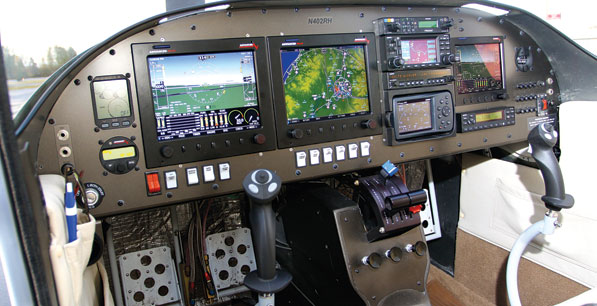
This might well be the new “typically equipped” RV-10, with triple Advanced Flight Systems screens, a two-axis autopilot, built-in oxygen and more GPSes than you can shake a stick at. A Tosten stick grip includes trim, plus buttons for the flap motor, the coffee machine, ejector seats and push-to-talk.
My first landing at the helm of an RV-10 in literally years followed a GPS approach guiding us down to a straight-in. With no opportunity to slow the airplane in the pattern or get accustomed to its low-speed handling, I elected to stick the airspeed tape on 70 KIAS and ride it down. Pitch changes with flaps are minimal—though the tiny, unmarked switches on the stick grip to control the flaps leave a lot to be desired, in my view—and the airplane is well-behaved as you coax it down the glidepath, slowing as you go. I can’t see how integrating the RV-10 into any approach stream would be hard work.
By carrying just a smidgen of power, the touchdown was soft and only a bit farther along the runway than I’d intended—a testament to the 10’s handling qualities. By about minute two behind the stick, I’d adapted to the higher-than-expected control pressures and soon began reveling in the stability and balance. True, it’s no RV-8 in roll, but the ailerons are smooth, with a definable force gradient and almost no breakout force. Minute changes in roll are easily accomplished. The stick moves more in maneuvering flight than a two-seat RV’s, but that is both expected and desirable.
From the standpoint of scaling up the 10’s goodness from its smaller brethren and also making it suitable as a cross-country airplane, I have to agree with Chuck Berthe’s assessment in the January 2005 issue of this magazine where he called the RV-10 “a good-looking airplane that flies as well as it looks.”
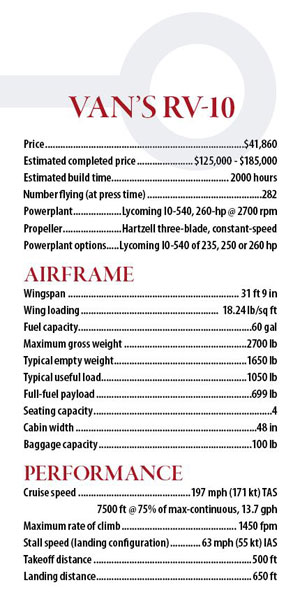
Bottom-Line Numbers
Speculation on why the RV-10 hasn’t sold by the millions centers on cost. The current price of $41,860 (or $54,125 if you take the quickbuild options) isn’t out of line for the size and capability of the aircraft. Expenses mount elsewhere. Choosing a six-cylinder engine (a new, Experimental-class Lycoming from Van’s) puts you in line for a $40,000 chunk, plus a more expensive prop. The panel is large, and you’re probably not going to resist filling it.
Running Van’s own cost estimator, the completed range falls between $123,000 and $137,000, but I think that’s underestimated because of the proclivity of the company to select a minimal avionics package. Most builders are dropping $30,000 to $40,000 on avionics alone—look at the size of Stein Bruch’s bass boat if you want confirmation—that’s a joke, kids. We have heard that one builder managed to finish a 10 for around $80,000, but that would require self-restraint and an overhauled engine, at least.
Among the kits available today—really available, not just brochure queens—the RV-10 is unique in its mix of capabilities, comfort and handling. It just passed the 1000-kits-sold mark, and as the fleet nears 300 flying, you definitely get the sense that the RV-10’s best years might still be ahead.
For more information, call 503/678-6545 or visit www.vansaircraft.com. For more on Advanced Flight Systems visit www.advanced-flight-systems.com.

